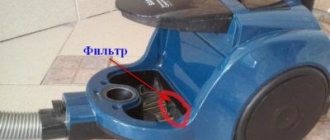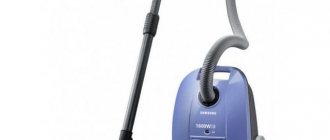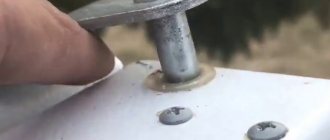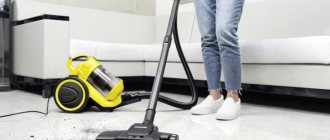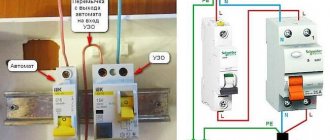In modern life, few people use hand tools such as a broom when cleaning. People try to automate this process as much as possible and make their work easier by using household cleaning equipment - a vacuum cleaner. Today's level of technical development makes it possible to purchase even fully robotic assistants for cleaning and washing floors, cleaning on a schedule. However, for all types and modifications of vacuum cleaners, the statement is relevant that the cleaning efficiency directly depends on the power of the device. What to do if this value has fallen, and how to increase it with your own hands - in the material below.
The vacuum cleaner works, but does not suck up dust well and gets hot
There are few reasons why a vacuum cleaner suddenly stops working effectively. This mainly concerns clogged filters, the dust container, the hose and the pipe on which the brush is mounted. Less common are reasons related to purely technical problems, such as incorrect operation of the electric motor.
What to do if power drops
All of the above troubles necessarily lead to a drop in air suction. Accordingly, the power of the unit also decreases, that is, you can forget about cleanliness of cleaning. The vacuum cleaner works, but removes dust ineffectively.
The hostess senses this immediately and begins to get nervous. The first thing you need to do is touch the body of the device. If it gets very hot, this indicates that the motor is running under load. This should not be allowed, because the engine should not operate in this mode for a long time. It will simply burn out, which will lead to large financial costs. Or it may even lead to the failure of the entire vacuum cleaner, which will have to be replaced with a new one.
Therefore, if the housing has become hot, the unit must be turned off and not used until the cause of this situation is identified.
Reasons for a sharp drop in suction power
From time to time, every owner of a vacuum cleaner is faced with the effect when the suction power of the unit drops sharply during the cleaning process. This may happen if:
- a foreign object is stuck in the pipe (rod) or hose;
- the power switch lever (located on the body of the vacuum cleaner) is accidentally moved;
- the hole for controlling the suction of the vacuum cleaner is open on the pipe;
- the suction hose is damaged;
- technical malfunctions have arisen related to the breakdown of the electric motor, which are often fatal or require professional repair.
You can eliminate the first three listed defects and increase the power of the vacuum cleaner with your own hands by simply visually inspecting the unit. To do this, you need to turn it off and carefully inspect it: the controls that are not in their places are set to their original position, the rod and hose are checked for clearance, having first disconnected them from the vacuum cleaner, and when they see a foreign object inside, they remove it and return all the parts to their original positions. places _
Hose break
As for repairing the suction hose, it most often breaks at the pipe clip or at the fitting with which it is connected to the vacuum cleaner. Any user can fix this problem. To do this you need:
- cut off the hose at the break point;
- clean the clip or fitting from hose remnants and accumulated dirt;
- connect the fitting/clip to the corrugated hose using the fasteners available there.
If the vacuum cleaner hose breaks in the middle, you can restore its functionality by using, for example, a piece of a bicycle tube of suitable length. It is pulled over the torn ends of the hose and secured with Moment glue. The same effect can be obtained if you use heat-shrinkable tubing:
Sometimes small cracks appear on the corrugated hose, through which air “siphons”. This reduces the suction power of the vacuum cleaner. This defect can be eliminated using a patch and PVC insulating tape.
Advice! Small cracks can be eliminated by carefully cutting the corrugated hose in the damaged area and twisting its ends onto each other. The junction is then carefully wrapped with insulating PVC tape.
Having eliminated the detected defects, the vacuum cleaner is turned on and cleaning continues.
Service technical reasons
In addition, loss of suction power can be caused by:
- small interturn short circuit in the motor windings;
- clogging or damage to the compressor impeller;
- damage to the body;
- malfunction of the cord winding mechanism;
- broken bearing seats in the housing, etc.
Eliminating these malfunctions will require complete disassembly of the vacuum cleaner, for which it is better to contact the service department or entrust the work to a professional technician with relevant experience . Otherwise, there is a risk of aggravating the situation - by your unskilled actions, you can damage the power and/or electrical components of the device, which can lead to additional costs for repairs or the purchase of a new vacuum cleaner.
Summarizing the above, it should be noted that for stable operation of household cleaning equipment, timely maintenance is necessary, which involves cleaning dust collectors, replacing, cleaning or washing (where permissible) filters. Then you won’t have to think about the decrease in suction power for a long time.
How to find the reason yourself
There is no need to take the vacuum cleaner to the specialist right away. There are several reasons that can easily be eliminated on your own. Let's look at them separately.
Checking the dust container and filters
The first thing to do is open the compartment where the dust collector is located.
Attention! Remember, as soon as the volume of the dust collector is filled by 2/3, the air flow that should pass through this part is blocked.
It is necessary to explain that the vacuum cleaner is designed like a ventilation system. That is, air is sucked in on one side and thrown out on the other. There are simply several parts and assemblies installed inside the device that stop and collect the sucked dust so that the sucked air does not pass back into the room being cleaned. Hence the rather stringent requirements for dust collectors.
If it is a bag, then it is made of dense filtration material folded in several layers. That is, air along with dust gets inside the bag and passes through it, leaving dust masses inside. 100% dust does not remain inside the bag, some of it leaks out because the air pressure is quite high. So, final cleaning is carried out by special filters installed along the direction of air movement.
And since after the dust collection compartment there is a section with an electric motor, it is important to protect the latter from the smallest particles of dirt. The thing is that, although the motor has a level of protection, dust does its negative work over time. Therefore, vacuum cleaner manufacturers install several filtration barriers using high-quality filtration materials.
It is these filters that, when clogged, do not allow air flow to pass through them well. Therefore, the vacuum cleaner does not suck as expected. This means that filters need to be cleaned periodically. This is done manually using a brush. You can do it without it - by cleaning the filtration element with your hands or another object, or by tapping.
As for the bag, it is simply emptied of its contents and shaken out well. And it is again ready to collect small debris and dust, plus delay the latter from penetrating into the engine compartment.
Some manufacturers supply vacuum cleaners with paper bags rather than fabric ones. They perform the same functions, but there is no point in cleaning them. They are simply thrown into the trash, installing a new one in the compartment.
The frequency of cleaning filter bags depends on the intensity of use of the vacuum cleaner. The more we use, the more often we clean.
Plastic containers
Vacuum cleaning bags are gradually disappearing into oblivion. They have been replaced by plastic containers that operate on the principle of a cyclone. That is, inside this dust collector, when the motor is turned on, an air funnel is formed, in which all the dust collects. As soon as the electric motor turns off, it immediately falls to the bottom of the container.
A plastic container installed instead of a bag has made life easier for housewives, because garbage disposal is much easier here:
- the lid opens;
- contents spill out;
- The internal surfaces are wiped with a damp cloth; the plastic container can even be washed.
Aqua filters
This is a plastic container into which water is poured, which acts as a filter. It is believed that the vacuum cleaner does not work due to water contamination. This is mistake. And although dirty fluid has to be replaced with a new one often, this still does not affect the suction power in any way. This vacuum cleaner will work efficiently. The only thing is that you will have to look out for additional filters.
But such models of vacuum cleaners have one feature. The water filter must be filled with a certain volume of water. That is, no more and no less, which is why there is a fill level on the container. The fact is that when air moves at great speed, it also takes water dust with it. But the air inside the device performs an important function - it cools the motor. If water gets into the air mass, this will soon affect the operation of the electric motor. It’s not uncommon for the engine to simply “burn out.”
Inspection of components
The vacuum cleaner kit includes various attachments for collecting dust, a hose and a metal tube connecting these two parts. All this can cause incorrect operation of the household appliance.
- A large object may get inside and block one of the components. For example, it could be a banal rag. It must be removed by any means. You can use a metal rod for this. It is better to remove the object from the nozzles with a stiff wire, making a hook at its end.
- The second reason why the vacuum cleaner does not suck up dust is damage to the hose. It could even be a small gap: transverse or longitudinal. This is enough to reduce the suction power.
- There is a specially installed opening on the metal pipe, which is tightly closed by the lid moving along it. Its purpose is to manually reduce the pressure inside the suction system without touching the speed switch on the device body. Over time, the seal of the lid weakens and air begins to leak through the gaps. This reduces power.
You can easily determine that one of these components is faulty:
- The vacuum cleaner turns on with the components connected.
- with disconnected.
If in the second case the device works better, and this will be audible, then it’s all about three elements. If no changes have occurred, then you need to look for another reason.
Possible engine malfunctions
Problems with the electric motor are rare. They usually appear after using the vacuum cleaner for a long time. Here are some of them:
- A whistle appeared inside the case, the device itself began to operate noisily. The reason is something happened to the motor bearings. More often the lubricant dries out.
- When plugged in, the engine did not start. If the power light does not come on, there is a problem with the plug or power cord. Or the fuses have blown. If the power light is on, but the motor does not turn on, then there are two reasons: something with the control board, something with the engine itself. The most dangerous thing is if it burns out.
- Sometimes the vacuum cleaner turns off by itself, but the power light is on. It was the engine overheating system that triggered. You just need to leave the device turned off for a few minutes. Then it will turn on again.
- The light is on, but it does not turn on. The switch may be to blame.
- The same can be said about the speed selector.
- If the engine starts to hum. In this case, no absorption occurs. The reason is that the graphite brushes inside the motor have worn out. They are replaced with new ones.
- Smells like burnt rubber. There are two reasons: problems with the plug and power cord, problems with the electric motor winding.
- The vacuum cleaner operates jerkily. It's all about the control board.
- No malfunctions were detected, but the vacuum cleaner stopped suction - what to do in this case. Option one is to check the voltage in the network. Any household appliance, including a vacuum cleaner, has precise voltage readings at which they operate correctly. Usually it is 220 volts, plus or minus 10 V.
Factors influencing power
In general, a vacuum cleaner is a unit whose operation is based on the suction of air flow. At the same time, dust and contaminants located on various surfaces are absorbed along with the air masses. There are a huge number of manufacturers on the world market (LG, Electrolux, etc.) producing a variety of models that differ in both design and technical characteristics. Moreover, almost all of them, despite the variety of design solutions, have the same set of main components:
- a powerful centrifugal compressor, with which the air flow is pumped through the filters of the vacuum cleaner;
- a filtration system designed to clean the air flow from dust;
- removable dust collector - a container where collected dust accumulates.
The operation of all models without exception is characterized by the values of power consumption and suction power (net power). And if the power consumed by a vacuum cleaner does not change throughout its entire service life, then its suction power decreases over time .
Power consumption
Modern vacuum cleaners differ significantly from old Soviet models in terms of power consumption. If such devices as “Raketa”, “Ural” and others consumed no more than 350-500 W from the network, then modern models (Samsung 1600w, Vitek 1400w, etc.) require from 1200 to 1800, and sometimes 2500 Watts . This is explained by the fact that current models have additional filters that capture dust particles with a size of about 1-10 microns. It was for their purging that the developers needed to increase the electrical power of the compressors.
On a note! An increase in the load on the electric motor required additional cooling. Therefore, in order for the engines to blow air over themselves, additional power is needed.
Suction power
As for the suction power, it is determined based on the electrical power of the compressor and the type of filters used. In general, you can determine the suction power of a particular device using the following relationships:
- for models with filters, the suction force is 20% of the power consumption;
- for models without a filter, the useful power is 0.9983 R, where R is the power consumption of the vacuum cleaner (W).
For handheld vacuum cleaners powered by a built-in or car battery, the suction capacity is determined by the capacity of the power source. During operation, the batteries are discharged and the suction power begins to decrease.
On a note! As a rule, the operating time of wireless models is (without recharging the batteries): when powered from a built-in source with a capacity of up to 1500 mAh - no more than 15 minutes, when connected to the cigarette lighter socket in the car - no more than 30 minutes.
Ways to solve problems
Having considered why vacuum cleaners have poor suction and heat, it is worth familiarizing yourself with the solution to these problems.
Everything related to the electric motor cannot be repaired on your own. This requires specialist intervention. Vacuum cleaner manufacturers are trying to improve product quality by installing high-quality components and parts. And if they fail, then more often than not they have served their time. Therefore, there is no point in repairing them. In workshops they are simply replaced with new ones.
A burnt-out motor winding can be replaced, but this still reduces the quality of the motor. Therefore, experts recommend changing it or purchasing a new vacuum cleaner. The winding burns out for four reasons:
- the bearings sagged, which caused the rotating rotor to sag, so it began to touch the stator winding, abrading it and removing the insulation;
- overheating of the winding, which causes the insulating layer to burn out;
- the collector becomes clogged;
- Water got on the winding.
Problems with liquids often arise. If the vacuum cleaner is not washable and does not have an aqua filter, then it cannot collect spilled liquids. Especially if there is a paper bag installed inside the vacuum cleaner. With any protection, even a small volume of water will penetrate inside the motor and reduce its service life.
Troubleshooting the board is possible, but only in a workshop. Here you have to look for an element that has burned out or stopped functioning due to the end of its service life. It is usually changed. It is rare that the entire plateau has to be removed. But this also happens.
If the voltage in the house is low, then the solution is simple - install a step-up transformer.
Design of a washing vacuum cleaner and principle of operation
The main function of a washing vacuum cleaner is that it is capable of wet cleaning of surfaces (Fig. 2), with its help you can wash windows and mirrors, upholstered furniture, but by turning off this option, you can use it like a regular vacuum cleaner, doing dry cleaning, which makes these household appliances convenient, multifunctional and therefore the most popular.
Fig.2 Functions of a washing vacuum cleaner
The household appliances market is represented by a wide range of washing vacuum cleaners; prices vary, as does the range of functions and attachments used. If necessary, you can buy additional attachments.
However, any of the representatives of this category will be simple and easy to use. It is important to carefully study the attached instructions before first use. Regardless of the price and set of options, the device and operating principle of the washing vacuum cleaner are the same.
Also find out from our article at the link: If you hold a vacuum cleaner on to your eye, what will happen?
Useful tips
The service life of a vacuum cleaner is affected by various parameters. Of course, first of all, a lot depends on the quality of production: high-quality components and parts, as well as their assembly into a single whole. Not all manufacturers can guarantee high quality assembly, and then there are more details themselves. But even such vacuum cleaners can work for several years without creating problems.
It is important to consider the following requirements:
- If the instructions for the device indicate the time that the vacuum cleaner should work without stopping, then it should not be exceeded.
- The dust container and other filters must be cleaned in a timely manner.
- During operation, you need to make sure that the hose does not twist. You shouldn’t carry the equipment by the hose; there’s a handle for that.
- Store the vacuum cleaner in a dry place.
- If these are ordinary models, then you cannot use them in wet rooms, and even more so, do not collect spilled liquids with them.
- The electric motor must not be allowed to overheat. To do this, it is enough to periodically touch the body with your hand.
- Use the unit carefully. Strong mechanical loads, especially shock, are not for him.
- Use different attachments in different situations. Particular attention should be paid to brushes, which wear out over time, making the cleaning process not as good as required.
- Some attachments have rotating rollers. When they jam, the dust collection process also becomes ineffective. Usually hair is wound onto rollers. So you have to remove them manually.
- Pay special attention to the start and stop button. You need to press it smoothly, no kicking. The same applies to the suction speed switching unit.
There is an enviable variety of vacuum cleaners on the market. There are inexpensive models, and there are premium ones. But they all have the same problem if the device is not used correctly. This is a drop in the efficiency of collecting dust and small debris, after which house cleaning cannot be called clean. Small problems can be solved independently, but there are some that require the intervention of a specialist. But, if you strictly follow the operating instructions from the manufacturer, you can guarantee that the device will work for a long time and without problems.
Engine damage
The most serious reason for loss of power and reduced traction of a vacuum cleaner is problems with the engine. Unfortunately, they are quite common on inexpensive devices. Manufacturers initially set aside a short motor life in order to stimulate constant demand for their products, since the cost of the motor is comparable to the cost of a new device.
But there are different problems with an electric motor. For example, it is quite possible to fix a breakdown associated with a broken wire contact or a blown fuse yourself. But more serious repairs are best left to specialists.
In any case, reliable and trouble-free operation of household electrical appliances depends on timely care for them. The procedure and frequency of performing specific equipment maintenance activities is always specified in the operating manual. Ignoring the manufacturer's recommendations is fraught with problems at the most inopportune moment.
Full trash bag
If everything is fine with the filters, consider other reasons why the vacuum cleaner is not pulling. The most common is that the garbage bag is overfilled. There are models that do not have an indicator to indicate when it needs to be released. Therefore, you need to manually check the dust collector. When it is 70% full, the vacuum cleaner's thrust is greatly reduced.
Therefore, if it stops sucking up dust, remove the debris from the dust container. There are three options for this part:
- plastic - waste is poured out of it, washed under water and dried;
- the paper bag is disposable, throw it away after filling;
- fabric is used several times, pour out the dust, shake out well.
Note! Shaking out does not always help to get rid of dust; it can get into the motor during operation. Therefore, it is better to wash the bag without soap and dry it.
Expert opinion
It-Technology, Electrical power and electronics specialist
Ask questions to the “Specialist for modernization of energy generation systems”
WHY THE VACUUM CLEANER DOESN’T SUCK DUST - 5 reasons Then the hose can be rinsed from the inside with running water and left in a warm room for several hours to dry completely. Ask, I'm in touch!
Remove construction debris and debris
The filtration system of household vacuum cleaners is quite complex and sensitive. Fine dust from construction mixtures clogs them and prevents air circulation; some of the debris gets into the motor. As a result of this, the suction power decreases sharply, the engine wears out, overheats and requires serious repairs, and sometimes fails completely.
If serious repair work awaits you in the foreseeable future, you can purchase an inexpensive vacuum cleaner for such cleaning, which you will not mind throwing away later.
Vacuuming up debris is a bad idea. They can easily damage the garbage collection bag, and all its contents, carefully collected from previous cleanings, will end up safely in the engine compartment and scatter around the room in a dusty cloud.
Washing vacuum cleaner device
The vacuum cleaner has 2 tanks for filling with water (Fig. 3):
- tank for clean water and detergents;
- container for draining dirty water.
Water containers can be located in several ways:
- horizontally;
- vertical;
- in each other.
Rice. 3 Water reservoirs in the washing vacuum cleaner
When placing a container one above the other to drain dirty used water, it is necessary to disassemble the structure completely. If the tanks are located one inside the other, then draining and adding clean water occurs faster, without the need for disassembly.
You can read about the main components of a vacuum cleaner in the article.
Filters are clogged
The air passing through the bag or container is further purified by passing through filters, thereby preventing the smallest dust particles from getting back into the room. If you do not clean or change this important part in time, the air flow will have nowhere to go, the suction will deteriorate, the motor will start working at full power, and all this can end very badly for the vacuum cleaner.
pylesos_tech
To prevent this from happening, you need to monitor the condition of the filter, clean it by rinsing it under running water, or replace it with a new one.
